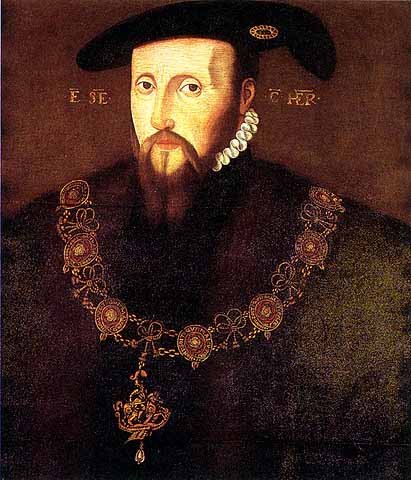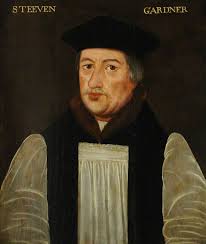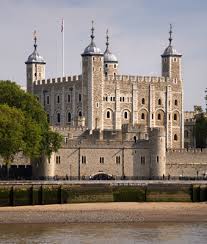William Cecil: Life Story
Elizabeth I’s Chief Councillor
Chapter 3 : Somerset's Man
When Henry VIII died in 1547, Hertford became Lord Protector, and Duke of Somerset. By the middle of that year, if not before, Cecil was in his direct employ. Within a year, Cecil had the post of Master of Requests – that is, he had the responsibility of reviewing petitions made to Somerset on to the appropriate divisions of the Courts at Westminster (not to be confused with the role of Master of the Court of Requests, a legal office).
Despite the fact that Somerset had fallen out with the Queen Dowager, Katherine Parr, Cecil remained on good terms with her. He wrote an effusive introduction to her devotional work, the Lamentations of a Sinner, which he registered for her at Stationer’s Hall in late 1547. This friendship with her step-mother may have been the root of Elizabeth and Cecil’s acquaintanceship.

In the political world of the sixteenth century, a system of favours and place-seeking for friends and family that we would consider corrupt, was the norm. The mediaeval concept of ‘good-lordship’ whereby the lower ranking person (both men and women) gave service, or gifts in return for the higher-ranking individual putting them forward for plum jobs continued, although, as the century progressed, it began to be questioned. Cecil was now in a position to do favours for people, and he began to be seen as a man of influence.
One of Somerset’s pet projects was the forcible absorption of Scotland into English domination. The project had been begun by Henry VIII, when his nephew, James V, died, leaving a week old baby as queen. Henry had leapt at the idea of marrying her to his son, Edward. The Scottish Regent, Arran, initially in favour, could not force the scheme through Parliament, and the little Queen Mary was hidden away from the risk of abduction by her terrifying great-uncle. Henry, with Somerset as his lieutenant, had made war on the recalcitrant Scots. Somerset, a notable soldier, continued the policy, and led an army north in person.
Cecil was part of this force, not, officially as a soldier, but as a judge of the Court of the Verge. This court was responsible for jurisdiction in disputes involving members of the sovereign’s court that took place within a 12-mile radius of wherever the sovereign happened to be. Presumably it was considered likely that there would be disputes between men on campaign. Whilst away, Cecil and his colleague, William Patten, kept journals.
Patten used their memoranda to write his book ‘The Expedition into Scotland’ published in 1548. The expedition was, from the English perspective, extremely successful, culminating on 10th September 1547 with the Battle of Pinkie Cleugh, which effectively annihilated Scotland’s army, and allowed the English, including Cecil, to burn Leith and besiege Edinburgh.
This vision of incorporating the neighbouring kingdom into a single, Protestant, country of Britain, followed Cecil throughout his life, and much of his later policy as Elizabeth’s chief minister was undertaken with the goal of achieving it.
Somerset’s rule also introduced extensive religious reforms, which Cecil wholeheartedly supported. Change began to be visible in churches in the summer of 1547, when, as well as reinforcing the requirement for an English Bible and a copy of Erasmus’ Paraphrases to be in every parish church, the incumbents were exhorted to remove anything that could tend to idolatry or image worship. The statues of the saints and the holy relics which had been objects of veneration for hundreds of years began to be removed, although wholesale destruction did not happen until after the passing of the Chantries Act of 1548.
This Act disbanded the religious guilds that had been such an important feature of mediaeval life: that mixture of civic duty and religious devotion that had built the churches and cathedrals, and instituted a whole system based on belief in the doctrine of purgatory. Now, prayers for the dead were outlawed, the chantries which had been endowed for priests to say Masses for souls for the dead were torn down, and a wave of window-smashing, and destruction of images rolled over the country.
The chantries had been staffed by priests who, when they were not saying the obligatory Masses (a priest could only offer two per day), frequently taught the local children. In just such a chantry school at Stamford had Cecil received his own education. Now, although Cecil was committed to reform, he used his influence to have a private act passed re-founding his old school as a Grammar School, affiliated to St John’s College, Cambridge and under the mastership of his old teacher, Libeus Byard.

Not everyone was happy with these religious changes. In particular, Stephen Gardiner, Bishop of Winchester, who had led the conservative faction in Henry VIII’s last years objected strongly to religious changes being made before Edward VI reached his majority. Cecil was sent by Somerset to try to persuade Gardiner to conform to government policy, but met with no success. Gardiner preached a very public sermon, condemning the changes.
Then came the 1549 Book of Common Prayer. Probably the work of Thomas Cranmer, Archbishop of Canterbury, it changed Church services from Latin to English, and reduced and changed some of the ceremony and ritual. It was based on the traditional Sarum rite of the English Church, and its central ceremony of the Eucharist was ambiguously worded, allowing for both Catholic and Protestant interpretation. Nevertheless, for the more conservatively minded (which was the vast majority of people outside London and East Anglia, where Protestantism flourished), it was unacceptable. Cornwall rose in revolt, in the Prayer Book Rebellion.
Almost simultaneously, in the east of the country, there was a rebellion motivated by economic factors, led by Robert Kett, eventually put down by John Dudley, Earl of Warwick.
Somerset’s inability to control events and his high-handed attitude to his colleagues on the Council had lost him popularity, and in the autumn of 1549 he was relieved of office. His friends and colleagues also suffered, and on 24 th November 1549, William Cecil was dispatched to the Tower of London.






